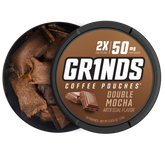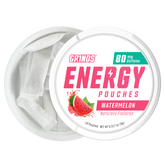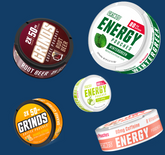How to Avoid a Caffeine Crash
We’ve already discussed how nicotine is more addictive than caffeine, but are there any downsides to regular caffeine use? The answer to that question can be complicated, but we’ll do our best to simplify it for you, and give it to you straight.
Using Caffeine Safely
Caffeine use has been studied at length and is generally accepted as a safe stimulant when used in doses of up to 400 mg per day. This is the equivalent of about four cups of coffee, ten cans of cola, two “energy shot” drinks, or an entire can of Grinds Coffee Pouches.
Wondering what caffeine does to your body? When taken by mouth for a long time or in high doses exceeding 400 mg per day, caffeine can produce the following negative side effects:
- insomnia
- nervousness and restlessness (also called “caffeine jitters”)
- stomach irritation
- nausea
- increased heart rate and respiration
- headache
- anxiety
- agitation
- chest pain
Keep your consumption levels below 400 mg, and you shouldn’t expect to experience any of these symptoms. The good news for Grinds fans: Because our coffee pouches contain such small amounts of caffeine, there aren’t any negative side effects from using Grinds Coffee Pouches.
Forms of Caffeine Consumption
Caffeine is mostly consumed by drinking beverages. (Some foods, such as chocolate, contain very small amounts of caffeine.)
A 2016 study shows that coffee makes up almost 2/3 of all caffeine consumption (64%) with tea coming in next at 18%. Close behind are caffeinated sodas at 15%, while energy drinks represent about 2% of caffeine consumption.
How Caffeine Works
When you use your brain and/or do a lot of physical activity, your body creates a chemical compound called adenosine that causes a sudden drop of energy. When adenosine meets up with certain receptors in your brain, it binds to them and acts like a key that “unlocks'' the receptors that tell your body to make you feel tired.
When caffeine is present in your system, it acts as a buffer that prevents adenosine from binding to the receptors that make you feel sleepy. This blockage allows you to feel more alert and focused, since your brain is temporarily unable to send messages to your central nervous system about feeling depleted and tired.
The key word to note here is temporarily—the adenosine is still there, just in hiding for a while. Once the caffeine is metabolized by enzymes in your body, it starts to go away and make room for the growing surplus of adenosine that has been building since before you consumed the caffeine.
Eventually the caffeine starts to wear off, usually an hour or two after consumption. This makes room for a flood of adenosine that’s been building up in your brain, and results in what most people know as “the caffeine crash” - an intense feeling of sleepiness, usually worse than you felt before consuming the caffeine.
How to Avoid “The Caffeine Crash”
The “crash” you experience from drinking beverages with high caffeine content can be mitigated by following some very simple guidelines. To prevent energy crashes:
- Keep caffeine doses within reason.
Remember, the maximum amount of caffeine an adult can safely consume is 400 mg per day. A single dose of more than 200 mg of caffeine at one time can lead to a caffeine crash. For comparison purposes, a single cup of coffee contains about 100 mg of caffeine, while a Grinds Coffee Pouch contains just 20-25 mg.
- Spread caffeine consumption throughout the day.
Instead of consuming your maximum daily allowance of caffeine all at once, try consuming smaller amounts throughout the day. Since Grinds Coffee Pouches contain small amounts of caffeine, that means it’s perfectly safe to consume them all day long and makes it easy to regulate caffeine intake.
- Get adequate rest.
If you don’t get enough sleep at night, you’ll start your day with high levels of adenosine, which puts you at a disadvantage from the moment you wake up. Get enough rest at night so you don’t feel sleepy during the day, and you won’t even need caffeine to get through it… or at least not as much of it!




